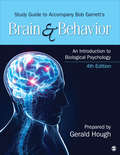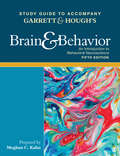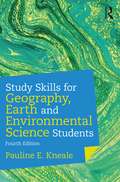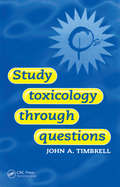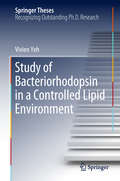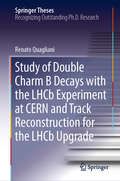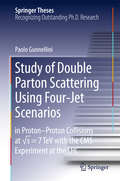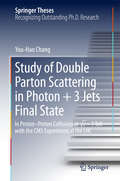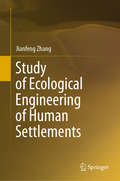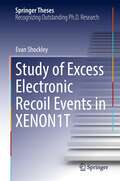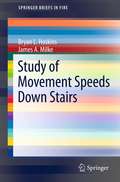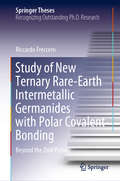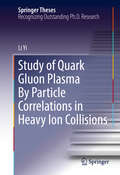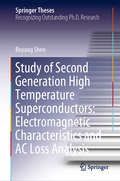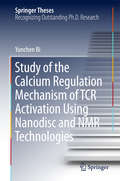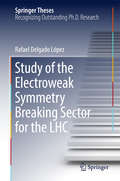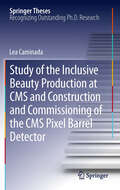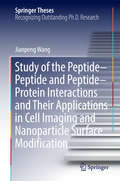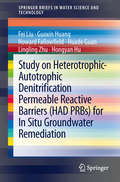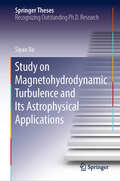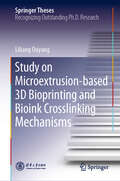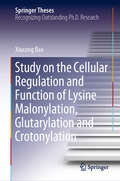- Table View
- List View
Study Guide to Accompany Bob Garrett’s Brain & Behavior: An Introduction to Biological Psychology
by Bob GarrettRevised by Gerald Hough to accompany the Fourth Edition of Bob Garrett’s best seller, Brain & Behavior: An Introduction to Biological Psychology, the fully updated Student Study Guide provides additional opportunities for student practice and self-testing. Featuring helpful practice exercises, short answer/essay questions, as well as post-test multiple choice questions, the guide helps students gain a complete understanding of the material presented in the main text. Save your students money! Bundle the guide with the main text. Use Bundle ISBN: 978-1-4833-1832-5. The main text, Brain & Behavior: An Introduction to Biological Psychology, Fourth Edition, showcases our rapidly increasing understanding of the biological foundations of behavior, engaging students immediately with easily accessible content. Bob Garrett uses colorful illustrations and thought-provoking facts while maintaining a “big-picture” approach that students will appreciate. Don’t be surprised when they reach their “eureka” moment and exclaim, “Now I understand what was going on with Uncle Edgar!”
Study Guide to Accompany Garrett & Hough's Brain & Behavior: An Introduction to Behavioral Neuroscience
by Bob Garrett Gerald HoughCompletely revised to accompany the best-selling Brain & Behavior: An Introduction to Behavioral Neuroscience, Fifth Edition, the Study Guide offers students even more opportunities to review, practice, and master course material. Featuring chapter outlines, learning objectives, summaries and guided reviews, short answer and essay questions, multiple choice post-test questions, and answer keys, the guide reflects important updates made to the content in the main text to enhance student understanding.
Study Guide to Accompany Garrett & Hough's Brain & Behavior: An Introduction to Behavioral Neuroscience
by Bob Garrett Gerald HoughCompletely revised to accompany the best-selling Brain & Behavior: An Introduction to Behavioral Neuroscience, Fifth Edition, the Study Guide offers students even more opportunities to review, practice, and master course material. Featuring chapter outlines, learning objectives, summaries and guided reviews, short answer and essay questions, multiple choice post-test questions, and answer keys, the guide reflects important updates made to the content in the main text to enhance student understanding.
Study Skills for Geography, Earth and Environmental Science Students
by Pauline E. KnealeThis guide will help you to survive and thrive during your degree and on into the workplace. Everything you do at university can be useful in your career. Packed with practical hints, study tips, short cuts, real-life examples and careers advice, the new expanded fourth edition of this book is an invaluable resource throughout your geography, earth science or environmental science studies. This book provides guidance for successful study on many topics including: Starting as a student Being an effective researcher Presenting information effectively in posters, presentations, essays and reports Time management, well-being and ethics Field and laboratory work Assessment and feedback Written in an accessible style, this guide also explains the role of the academic, and how it differs from that of a school teacher. It prepares you for the world of work by showing how the skills you learn at university today can be used in your career choice of tomorrow.
Study Toxicology Through Questions
by John TimbrellA compilation of questions with answers for students of toxicology. The questions are a mixture of short answer, problem-solving, data interpretation and multiple choice and cover all the major areas of toxicology.
Study of Bacteriorhodopsin in a Controlled Lipid Environment (Springer Theses)
by Vivien YehThis book focuses on the study of how the properties of nanodiscs, such as lipid composition and size, influence the function of the embedding integral membrane protein, bacteriorhodopsin. The author performed systematic studies to show that the lipid composition and the charge of the hydrophobic head and the structure of hydrophilic tails affect the photocycle pathway of bacteriorhodopsin, which is closely associated with its proton-pumping activity. Furthermore, the author demonstrated a highly efficient method for extracting membrane proteins directly from the biological membrane, preserving protein conformation, function and essential native lipids. This book demonstrates optimization and sample preparation, and presents practical methods of preparing membrane protein-embedded nanodisc samples for biophysical studies, which benefit structural and functional studies in the field of membrane protein characterization, both.
Study of Double Charm B Decays with the LHCb Experiment at CERN and Track Reconstruction for the LHCb Upgrade
by Renato QuaglianiThis book discusses the study of double charm B decays and the first observation of B0->D0D0Kst0 decay using Run I data from the LHCb experiment. It also describes in detail the upgrade for the Run III of the LHCb tracking system and the trigger and tracking strategy for the LHCb upgrade, as well as the development and performance studies of a novel standalone tracking algorithm for the scintillating fibre tracker that will be used for the LHCb upgrade. This algorithm alone allows the LHCb upgrade physics program to achieve incredibly high sensitivity to decays containing long-lived particles as final states as well as to boost the physics capabilities for the reconstruction of low momentum particles.
Study of Double Parton Scattering Using Four-Jet Scenarios
by Paolo GunnelliniThis thesis addresses in a very new and elegant way several measurements and the extraction of so-called double parton scattering. The new and elegant way lies in the combination of measurements and a very smart extraction of double parton scattering results, which is easy to apply and overcomes many of the technical difficulties of older methods. Many new phenomena in particle physics can be observed when particles are collided at the highest energies; one of the highlights in recent years was the discovery of the Higgs boson at the Large Hadron Collider at CERN. Understanding the production mechanism of the Higgs boson at the LHC requires detailed knowledge of the physics of proton-proton collisions. When the density of partons in the protons becomes large, there is a non-negligible probability that more than one parton participates in the interaction and the so-called double parton scattering becomes important. In some cases very particular final state signatures can be observed, which can be regarded as an indication of such double partonic scattering and where the different interactions can be separated. Such multiple partonic interactions play an important role when precise predictions from known processes are required.
Study of Double Parton Scattering in Photon + 3 Jets Final State
by You-Hao ChangThis book mainly focuses on the study of photon + 3 jets final state in Proton-Proton Collisions at √s = 7TeV, searching for patterns of two (or more) distinct hard scatterings in the same collision, i. e the so-called Double Parton Scattering (DPS). A new method by using Monte Carlo generators was performed and provides higher order corrections to the description of the Single Parton Scattering (SPS) background. Further it is investigated whether additional contributions from DPS can improve the agreement between the measured data and the Monte Carlo predictions. The current theoretical uncertainties related to the SPS background are found to be larger than expectation. At the same time a rich set of DPS-sensitive measurements is reported for possible further interpretation.
Study of Ecological Engineering of Human Settlements
by Jianfeng ZhangThis book analyzes the theory of ecological engineering of human settlements and provides case studies on the improvement of degraded lands and vegetation restoration, especially focusing on saline-alkali land, abandoned land, water source areas, and the impact of green belts on noise and air quality on the highways. In addition, it discusses the issue of biodiversity conservation strategies in rural landscape construction and demonstrates experiment measurement and field survey methods. The results obtained are supplemented by numerical calculations, presented in the form of tables and figures.As the first monograph on this subject, the book provides a wealth of ideas and resources for researchers, professionals and practitioners in the field of human settlements.
Study of Excess Electronic Recoil Events in XENON1T (Springer Theses)
by Evan ShockleyThis thesis summarizes the original analysis work performed by the author on data from XENON1T, a search for dark matter with a ton-size noble liquid detector operated at Gran Sasso Underground Laboratory in Italy. The nature of dark matter is one of the most open and pressing questions of modern physics, and the unique data acquired with this detector allows the exploration and investigation of several potential scenarios. The analysis of Dr. Shockley searches for a class of elusive elementary particles that interact with the electrons of ordinary atoms, instead of the nucleus. Results of the analysis present, with high confidence, an excess with respect to the expected background. Beyond more mundane explanations, this additional rate of electron-mediated interactions might be a first hint of physics beyond the standard model. This accessible thesis provides details on the detector, the data, and the theory, delivering to the reader an in-depth and coherent picture of the search for physics beyond the standard model.
Study of Movement Speeds Down Stairs
by James A. Milke Bryan L. HoskinsThe Study of Movement Speeds Down Stairs closely examines forty-three unique case studies on movement patterns down stairwells. These studies include observations made during evacuation drills, others made during normal usage, interviews with people after fire evacuations, recommendations made from compiled studies, and detailed results from laboratory studies. The methodology used in each study for calculating density and movement speed, when known, are also presented, and this book identifies an additional seventeen variables linked to altering movement speeds. The Study of Movement Speeds Down Stairs is intended for researchers as a reference guide for evaluating pedestrian evacuation dynamics down stairwells. Practitioners working in a related field may also find this book invaluable.
Study of New Ternary Rare-Earth Intermetallic Germanides with Polar Covalent Bonding: Beyond the Zintl Picture (Springer Theses)
by Riccardo FrecceroThe thesis focuses on the syntheses, structural characterizations and chemical bonding analyses for several ternary R–M–Ge (R = rare earth metal; M = another metal) intermetallics. The challenges in understanding the main interactions governing the chemistry of these compounds, which lead to our inability to predict their formation, structure and properties, are what provided the motivation for this study. In particular, the R2MGe6 (M = Li, Mg, Al, Cu, Zn, Pd, Ag), R4MGe10-x (M = Li, Mg), R2Pd3Ge5, Lu5Pd4Ge8, Lu3Pd4Ge4 and Yb2PdGe3 phases were synthesized and structurally characterized. Much effort was put into the stabilization of metastable phases, employing the innovative metal flux method, and into the accurate structure solution of twinned crystals. Cutting-edge position-space chemical bonding techniques were combined with new methodologies conceived to correctly describe the Ge–M, Ge–La and also La–M polar-covalent interactions for the La2MGe6 (M = Li, Mg, Al, Cu, Zn, Pd, Ag) series. The present results constitute a step forward in our comprehension of ternary germanide chemistry as well as providing a good playground for further investigations.
Study of Quark Gluon Plasma By Particle Correlations in Heavy Ion Collisions
by Li YiThis thesis covers several important topics relevant to our understanding of quark-gluon plasma. It describes measurement of the third-order harmonic flow using two-particle correlations and isolation of flow and non-flow contributions to particle correlations in gold-gold collisions, and investigation of the long-range longitudinal correlations in small systems of deuteron-gold collisions. The former is related to the hydrodynamic transport properties of the quark-gluon plasma created in gold-gold collisions. The latter pertains to the question whether hydrodynamics is applicable to small systems, such as deuteron-gold collisions, and whether the quark-gluon plasma can be formed in those small-system collisions. The work presented in this thesis was conducted with the STAR experiment at the Relativistic Heavy Ion Collider at Brookhaven National Laboratory, where the center-of-mass energy of both collision systems was a factor of 100 larger than the rest mass of the colliding nuclei. The results contained in this thesis are highly relevant to our quest for deeper understanding of quantum chromodynamics. The results obtained challenged the interpretation of previous works from several other experiments on small systems, and provoked a fresh look at the physics of hydrodynamics and particle correlations pertinent to high energy nuclear collisions.
Study of Second Generation High Temperature Superconductors: Electromagnetic Characteristics and AC Loss Analysis (Springer Theses)
by Boyang ShenThis thesis introduces a systematic study on Second Generation (2G) High Temperature Superconductors (HTS), covering a novel design of an advanced medical imaging device using HTS, and an in-depth investigation on the losses of HTS.The text covers the design and simulation of a superconducting Lorentz Force Electrical Impedance Tomography. This is potentially a significant medical device that is more efficient and compact than an MRI, and is capable of detecting early cancer, as well as other pathologies such stroke and internal haemorrhages. It also presents the information regarding the fundamental physics of superconductivity, concentrating on the AC losses in superconducting coils and tapes.Overall, the thesis signifies an important contribution to the investigation of High Temperature Superconductors. This thesis will be beneficial to the development of advanced superconducting applications in healthcare as well as more broadly in electrical and energy systems.
Study of the Calcium Regulation Mechanism of TCR Activation Using Nanodisc and NMR Technologies
by Yunchen BiThis thesis describes the use of biophysical and biochemical methods to prove that calcium has a positive feedback effect on amplifying and sustaining CD3 phosphorylation and should enhance T-cell sensitivity to foreign antigens. The study presented shows that calcium can regulate the signal pathway in cells not only as a secondary messenger but also through direct interactions with the phospholipid bilayer. The approach used in the thesis also represents an important advance, as it couples the use of nuclear magnetic resonance (NMR) to the analysis of signaling phenomena in living cells. Moreover, the thesis optimizes the Nanodisc assembly protocol, which can broaden its range of applications in membrane protein studies. A preliminary study on the structure of dengue virus NS2B-NS3p in complex with aprotinin, which may help to develop new drugs against the dengue virus, is also included.
Study of the Electroweak Symmetry Breaking Sector for the LHC
by Rafael Delgado LópezIn this dissertation, we revisit the prospects of a strongly interacting theory for the Electroweak Symmetry Breaking Sector of the Standard Model, after the discovery of a Higgs-like boson at 125GeV. As the LHC constrains new phenomena near the Higgs mass, it is natural to assume that the new scale is of order 1TeV. This mass gap might indicate strongly interacting new physics. This work is of quite general validity and model independence. With only a few parameters at the Lagrangian level, multiple channels (possibly with new physics resonances) are describable, and many BSM theories can be treated. It will be of interest to postgraduate students and researchers, and is accessible to newcomers in the field. Many calculations are given in full detail and there are ample graphical illustrations.
Study of the Inclusive Beauty Production at CMS and Construction and Commissioning of the CMS Pixel Barrel Detector
by Lea CaminadaThis thesis describes one of the first measurements made at CERN's Large Hadron Collider, the world's largest and highest-energy particle collider. The method of analysis described in the first part is applied to the first CMS collision data collected after the LHC startup in 2010 and leads to the first experimental result for the inclusive b cross section using semileptonic decays at a center of mass energy of 7 TeV. The second part of the thesis describes the building and testing of the barrel pixel detector; the author herself played an important role in its construction, commissioning and first exploitation. The CMS collaboration Thesis Award Committee selected this work as the best thesis of the year 2010
Study of the Peptide-Peptide and Peptide-Protein Interactions and Their Applications in Cell Imaging and Nanoparticle Surface Modification
by Jianpeng WangThis thesis focuses on the study of interactions between protein and peptides and their potential applications in cell imaging and nanoparticle surface modification. Drawing inspiration from naturally occurring coiled-coil binding pairs, it proposes a novel covalent peptide tag and probe system, based on the concept of affinity guided covalent conjugation. This newly established methodology provides complementary resolution to protein labeling, imaging and trafficking. By systematically investigating the coordination interaction between protein and quantum dots using various engineered protein ligands, this thesis proposes a general rule for protein self-assembly on the surface of quantum dots and reports a revolutionized nanobelt protein in accordance with this rule. It is an extraordinary example of interdisciplinary research, providing answers to real-life biological problems from a chemistry perspective. "
Study on China’s Industrial Competitiveness
by Yanyun ZhaoThis book builds an information platform on China's industrial competitiveness, providing scientific design and application case studies for integrated analysis and decision-making facilities and mechanisms for enterprises, industries, financial institutions and governments, which can make up for the lack of adequate information in China's market operations, especially the problems of duplicate construction and vicious competition aggravated by the lack of systematically processed industrial information. This book not only pursues innovation in technical methods and application theories but also pursues the collection, processing and collation of relevant domestic and international data and development and application so as to provide primary results for an industrial competitiveness database adapted to government management needs. The research is closely related to the actual problems in China and extensively uses statistical data to make various model analyses, which has a relatively sizeable academic value.
Study on Heterotrophic-Autotrophic Denitrification Permeable Reactive Barriers (HAD PRBs) for In Situ Groundwater Remediation
by Fei Liu Huade Guan Lingling Zhu Hongyan Hu Guoxin Huang Howard Fallowfield"Heterotrophic-Autotrophic Denitrification Permeable Reactive Barriers (HAD PRBs) for Groundwater in Situ Remediation" is an unmatched reference work on PRBs for groundwater in situ remediation. It proposes a novel HAD PRB approach for nitrate-contaminated groundwater remediation, and provides a systematic and clear explanation of design concepts and denitrification mechanisms. The book consists of four chapters, each of which covers key aspects of HAD PRBs. It provides rich, easy-to-follow illustrations, tables and references. Unique as a comprehensive reference work on the subject, it will serve as a valuable resource for all engineers and scientists active in environmental science and engineering, groundwater science, engineering and molecular biology. Prof. Fei Liu works at China University of Geosciences (Beijing), China. Dr. Guoxin Huang works at Beijing Academy of Food Sciences, China. Both Prof. Howard Fallowfield and Prof. Huade Guan work at Flinders University, Australia. Assistant Engineer Lingling Zhu works at Geological Publishing House, China. Assistant Engineer Hongyan Hu works at Hydrogeology and Engineering Geology Prospecting Institute of Heilongjiang Province, China.
Study on Magnetohydrodynamic Turbulence and Its Astrophysical Applications (Springer Theses)
by Siyao XuTurbulence and magnetic fields are ubiquitous in the Universe. Their importance to astronomy cannot be overestimated. The theoretical advancements in magnetohydrodynamic (MHD) turbulence achieved during the past two decades have significantly influenced many fields of astronomy. This book provides predictive theories of the magnetic field generation by turbulence and the dissipation of MHD turbulence.These fundamental non-linear problems were believed to be tractable only numerically. This book provides complete analytical descriptions in quantitative agreement with existing numerics, as well as theoretical predictions in physical regimes still unreachable by simulations, and explanations of various related observations. It also discusses and promotes the astrophysical applications of MHD turbulence theories, including (i) the particle acceleration and radiation in high-energy phenomena, e.g., Gamma-Ray Bursts, supernova remnants, cosmic rays; (ii) interstellar density fluctuations and the effect on observations, e.g., Faraday rotation, scattering measurements of Galactic and extragalactic radio sources; (iii) density and magnetic field structure in molecular clouds toward star formation. In closing, this book demonstrates the key role of MHD turbulence in connecting diverse astrophysical processes and unraveling long-standing astrophysical problems, as foreseen by Chandrasekhar, a founder of modern astrophysics.
Study on Microextrusion-based 3D Bioprinting and Bioink Crosslinking Mechanisms (Springer Theses)
by Liliang OuyangThis book presents a comprehensive study on microextrusion-based 3D bioprinting technologies for bioinks with various crosslinking mechanisms, chiefly focusing on the bioprinting process and bioink properties to provide readers with a better understanding of this state-of-the-art technology. Further, it summarizes a number of general criteria and research routes for microextrusion-based 3D bioprinting using three experimental studies based on shear-thinning, thermo-sensitive and non-viscous hydrogel bioinks. The book also presents sample applications in the areas of stem cells and cell matrix interaction. The book highlights pioneering results in the development of bioprinting technologies and bioinks, which were published in high-quality journals such as Advanced Materials, Biofabrication and ACS Biomaterials Science & Engineering. These include an in-situ crosslinking strategy that overcomes the viscosity limits for bioinks, which is virtually impossible using conventional strategies, and can be generalized for other bioink formulations.
Study on Quality of Life of Chinese Residents with Social Change
by Peigang WangThis book makes a systematic empirical analysis of the quality of life of Chinese residents from the perspective of social change, expounds the connotation, theory, elements, and research methodology of the quality of life, and focuses on the diachronic dynamic analysis of the multidimensional elements of the quality of life from the perspective of life course and life cycle. According to the research content, the book is divided into three topics. The first topic, from the first chapter to the third chapter, mainly focuses on the quality of life research and theoretical evolution, providing theoretical guidance for the empirical analysis of the book and scientific significance for the study of the quality of life in social change. The second project, from Chapter 4 to Chapter 7, focuses on the influence factors of quality of life of a Chinese resident, structure composition, and the relationship between the related factors to conduct empirical research, the purpose is to more clearly understand the present status of life quality in the Chinese culture, for the further scientific research was related to quality of life to provide the basic framework. The third topic, from Chapter 8 to Chapter 13, focuses on empirical analysis of the changes and development of subjective and objective quality of life of Chinese residents.
Study on the Cellular Regulation and Function of Lysine Malonylation, Glutarylation and Crotonylation (Springer Theses)
by Xiucong BaoThis book presents pioneering findings on the characterization of cellular regulation and function for three recently identified protein posttranslational modifications (PTMs): lysine malonylation (Kmal), glutarylation (Kglu) and crotonylation (Kcr). It addresses three main topics: (i) Detecting Kmal substrates using a chemical reporter, which provides important information regarding the complex cellular networks modulated by Kmal; (ii) Identifying Kglu as a new histone PTM and assessing the direct impact of histone Kglu on chromatin structure and dynamics; and (iii) Revealing Sirt3’s value as a regulating enzyme for histone Kcr dynamics and gene transcription, which opens new avenues for examining the physiological significance of histone Kcr. Taken together, these studies provide information critical to understanding how these protein PTMs are associated with various human diseases, and to identifying therapeutic targets for the dysregulation of these novel protein markers in various human diseases.
